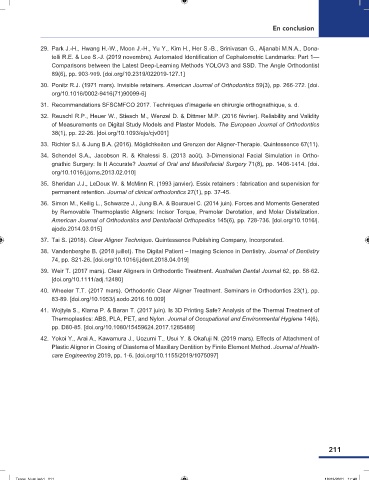Page 211 - Trans-Num-V1
P. 211
En conclusion
29. Park J.-H., Hwang H.-W., Moon J.-H., Yu Y., Kim H., Her S.-B., Srinivasan G., Aljanabi M.N.A., Dona-
telli R.E. & Lee S.-J. (2019 novembre). Automated Identification of Cephalometric Landmarks: Part 1—
Comparisons between the Latest Deep-Learning Methods YOLOV3 and SSD. The Angle Orthodontist
89(6), pp. 903‑909. [doi.org/10.2319/022019-127.1]
30. Ponitz R.J. (1971 mars). Invisible retainers. American Journal of Orthodontics 59(3), pp. 266‑272. [doi.
org/10.1016/0002-9416(71)90099-6]
31. Recommandations SFSCMFCO 2017. Techniques d’imagerie en chirurgie orthognathique, s. d.
32. Reuschl R.P., Heuer W., Stiesch M., Wenzel D. & Dittmer M.P. (2016 février). Reliability and Validity
of Measurements on Digital Study Models and Plaster Models. The European Journal of Orthodontics
38(1), pp. 22‑26. [doi.org/10.1093/ejo/cjv001]
33. Richter S.I. & Jung B.A. (2016). Möglichkeiten und Grenzen der Aligner-Therapie. Quintessence 67(11).
34. Schendel S.A., Jacobson R. & Khalessi S. (2013 août). 3-Dimensional Facial Simulation in Ortho-
gnathic Surgery: Is It Accurate? Journal of Oral and Maxillofacial Surgery 71(8), pp. 1406‑1414. [doi.
org/10.1016/j.joms.2013.02.010]
35. Sheridan J.J., LeDoux W. & McMinn R. (1993 janvier). Essix retainers : fabrication and supervision for
permanent retention. Journal of clinical orthodontics 27(1), pp. 37-45.
36. Simon M., Keilig L., Schwarze J., Jung B.A. & Bourauel C. (2014 juin). Forces and Moments Generated
by Removable Thermoplastic Aligners: Incisor Torque, Premolar Derotation, and Molar Distalization.
American Journal of Orthodontics and Dentofacial Orthopedics 145(6), pp. 728‑736. [doi.org/10.1016/j.
ajodo.2014.03.015]
37. Tai S. (2018). Clear Aligner Technique. Quintessence Publishing Company, Incorporated.
38. Vandenberghe B. (2018 juillet). The Digital Patient – Imaging Science in Dentistry. Journal of Dentistry
74, pp. S21‑26. [doi.org/10.1016/j.jdent.2018.04.019]
39. Weir T. (2017 mars). Clear Aligners in Orthodontic Treatment. Australian Dental Journal 62, pp. 58‑62.
[doi.org/10.1111/adj.12480]
40. Wheeler T.T. (2017 mars). Orthodontic Clear Aligner Treatment. Seminars in Orthodontics 23(1), pp.
83‑89. [doi.org/10.1053/j.sodo.2016.10.009]
41. Wojtyła S., Klama P. & Baran T. (2017 juin). Is 3D Printing Safe? Analysis of the Thermal Treatment of
Thermoplastics: ABS, PLA, PET, and Nylon. Journal of Occupational and Environmental Hygiene 14(6),
pp. D80‑85. [doi.org/10.1080/15459624.2017.1285489]
42. Yokoi Y., Arai A., Kawamura J., Uozumi T., Usui Y. & Okafuji N. (2019 mars). Effects of Attachment of
Plastic Aligner in Closing of Diastema of Maxillary Dentition by Finite Element Method. Journal of Health-
care Engineering 2019, pp. 1‑6. [doi.org/10.1155/2019/1075097]
211
18/03/2021 17:48
Trans_Num.indd 211
Trans_Num.indd 211 18/03/2021 17:48

